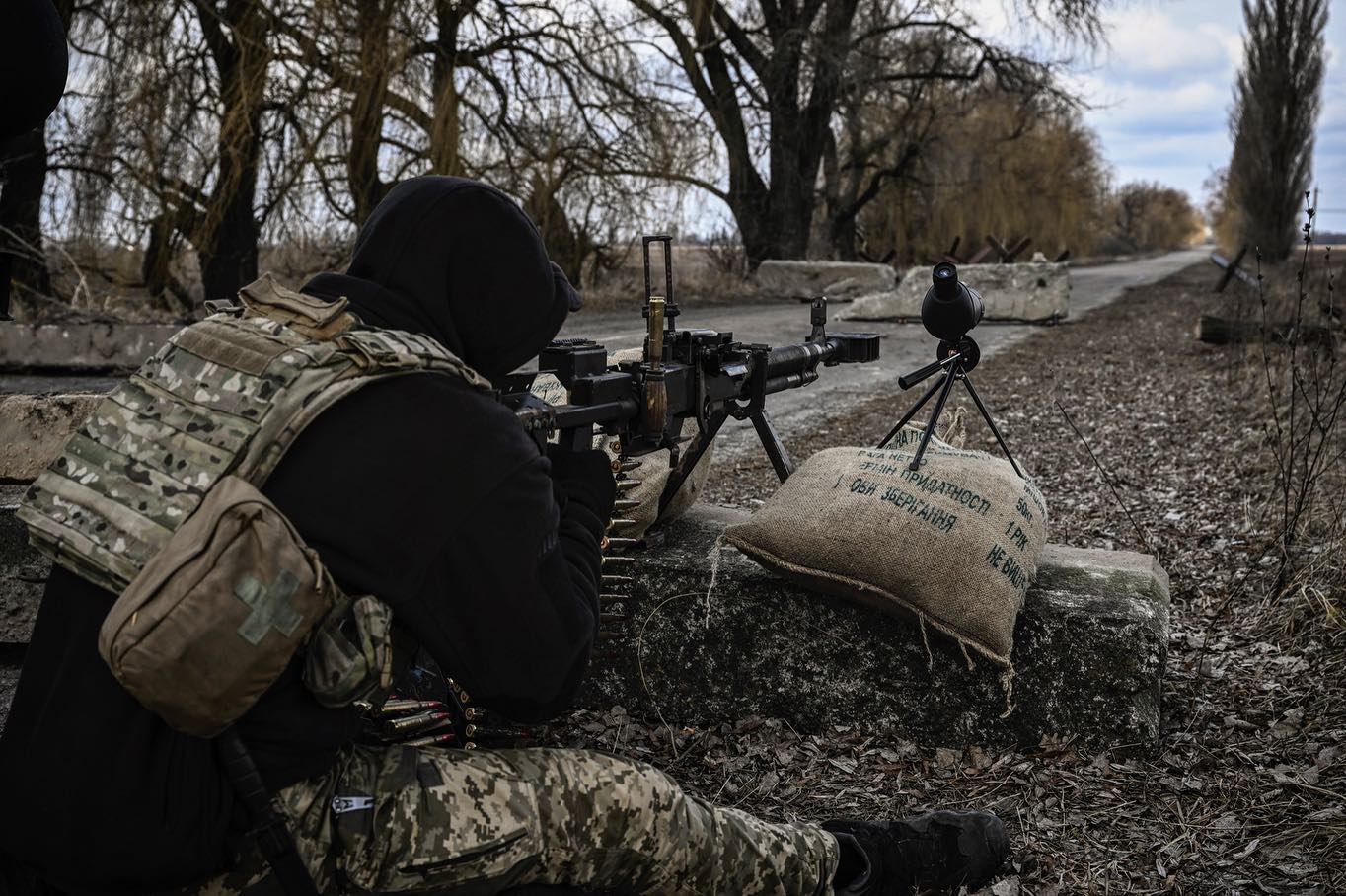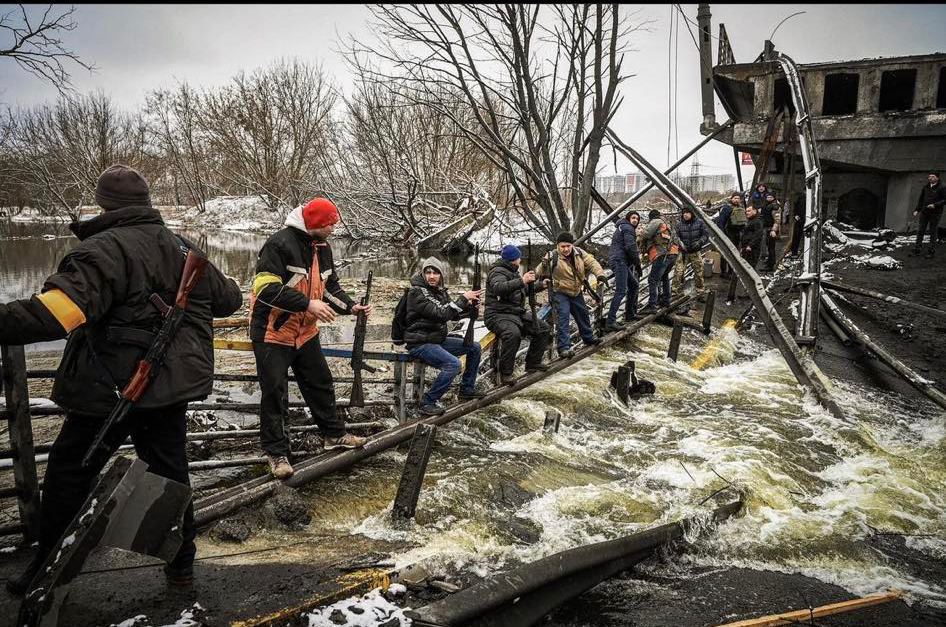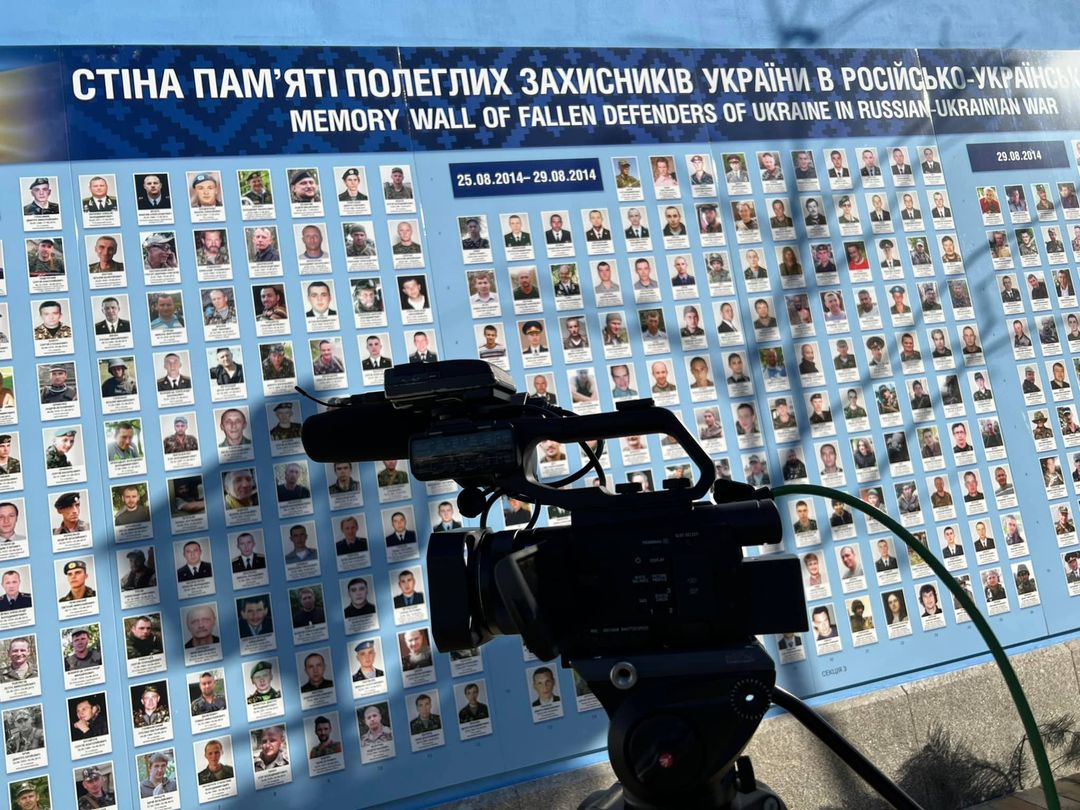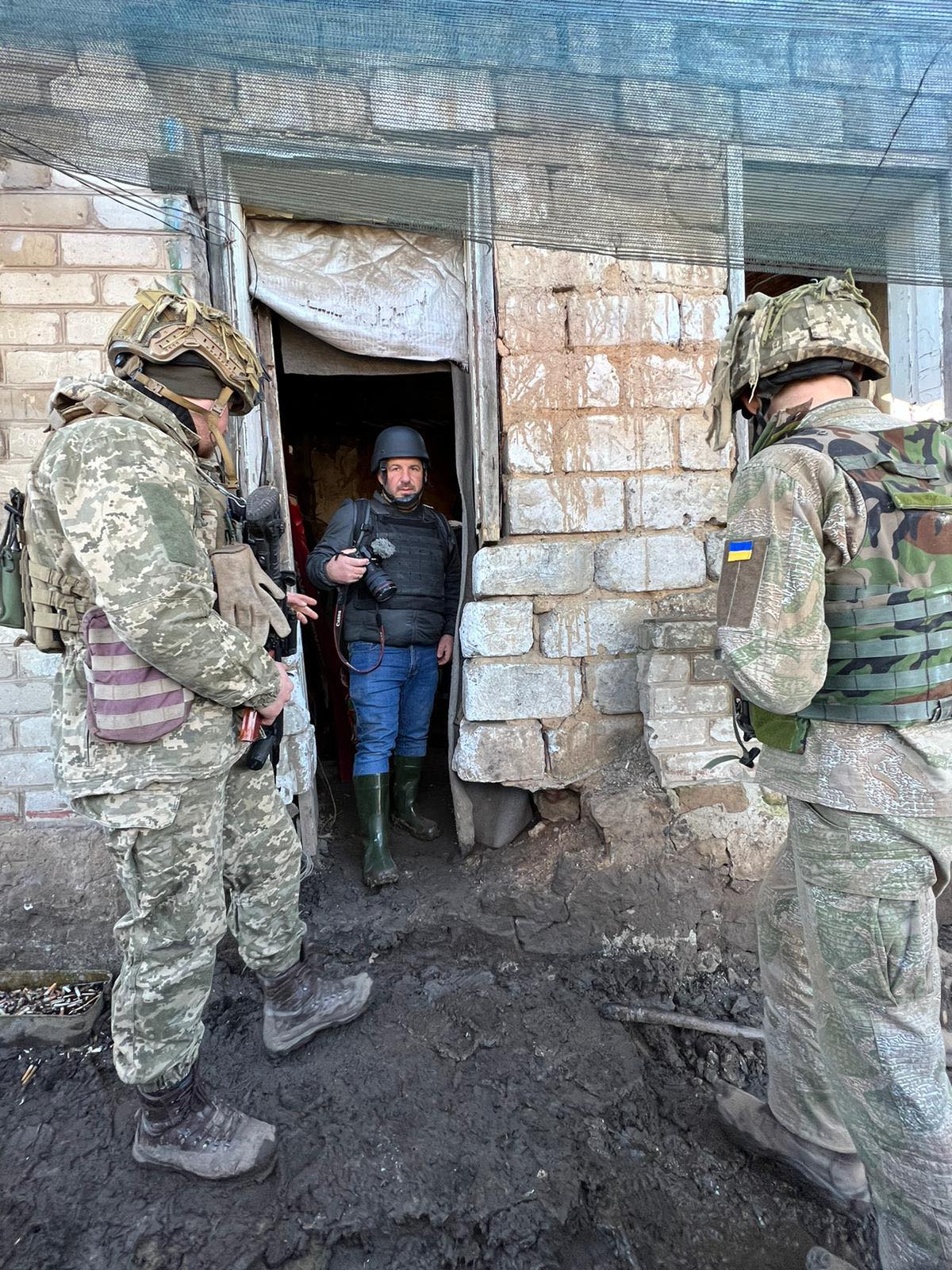Never in history has there been such a large presence of Press representatives at a war.
Never in history have international organizations and media professional representatives had only partial information about the total number of journalists in the field.
Never in history has there been such a crowding of inexperienced war correspondents.
Never in history has there been such an unbalanced coverage of the warring parties.
The Russian invasion of Ukraine -a war at the heart of Europe in the 21st century- has created a new status quo, not only with regard to geopolitical issues, but also to journalism and journalists.
Platforms, people with cellphones, social media, propaganda, provocation, fake news, competition, satellites, movement bans, embargos, jokers are the “nuclear” weapons of an information warfare – not only in terms of manipulating the public opinion, but also in the context of Eastern and Western strategies and tactics in the field.
3.500 journalists in the war zone
We have spoken with several correspondents in Ukraine and press groups, in an effort to understand the specific characteristics of covering this war and the conditions to secure their safety in the field.
More than 3.500 media professionals are located in some region of Ukraine; some of them not accredited, others without having notified their arrival to any authority and others with absolutely no experience in handling such situations.
At the same time, it is rather the first war in history covered by so many women journalists. For instance, the Greek national broadcast television had five women correspondents until recently, while all other TV stations and Greek media have teams of reporters with a large female presence.
This high concentration of Press people constitutes a unique characteristic, which helps us to understand the situation that prevails, the risks related to it, the feeling of insecurity among journalists, but also the circumstances that the Ukranian authorities are required to deal with.

In the line of fire
“We have been shot, although the lead car of the convoy was an official car with diplomatic plates and the next five cars were displaying large “PRESS” markings”. Our return journey from Mariupol began with a convoy of approximately 30 vehicles. We were not quite so sure, however, whether the Russians or the Ukrainians were the ones who opened fire. This incident took place a few kilometers after the village of Mangus, about 10 klm. away from Mariupol, which had just been brought under the Russian control. Even so, I can’t say for sure that it was the Russians who opened fire, because there was a conflict between forces in the wider region”, reported Stavros Ioannidis who was in the region of Mariupol for 20 days, covering the war on behalf of SKAI TV.
Nikolas Vafeiadis, who has covered 17 war conflicts and is now in Kyiv, covering the war for ANT1 TV, notes: “Once you’re in Ukraine, you’re in danger. Once you go out into the field, you’ll go to places where you will be in danger. You knowingly do that and those who have the experience, are taking the appropriate measures; it is not certain though that these measures or the equipment will save your life. Unfortunately, in a war, there are also random attacks and reporters are also at risk from these”.
To the question whether experience is an ally in this kind of news reporting, he replies: “It is uncertain whether experience will save you. The experienced ones often get the short end of the stick, due to excessive confidence”. And he goes on to say that “The existence of militias at roadblocks causes insecurity. We are talking about armed unpredictable citizens, who have no hesitation at the drop of a had in raising their weapon and waving the barrel and it does not take much effort to make a fatal mistake”.
The experienced photojournalist Aris Messinis, who has covered six wars through his photographs and is now in Kyiv on behalf of the Agence France-Press (AFP news agency) also referred to the security conditions: “There is a fear, there’s always a fear; however, there is a great deal of fear here, since the Ukrainians have armed whoever is on his/her feet and wishes to volunteer. That is a problem; militias are a major problem. Either you do or do not have a media accreditation, you always feel that you are in a high-risk situation. At militia blocks, even if we are wearing the equipment indicating that we are war correspondents, they have many times drawn a weapon threateningly or have screened us with great “enthusiasm””. And he adds: “I have no sense of security; Most of all, I am counting on my instinct, together with my experience from similar situations. Looking at the “PRESS” marking on the bulletproof waistcoat, they are likely to be less aggressive. If it is clearly visible, it may in some cases save you or ensure a calmer treatment, given the circumstances of the moment. Also, the fact that most of them do not speak English is no less of a problem and it is very difficult to communicate with them, with all the consequences that that entails”.
Given his experience in battle zones, Aris Messinis refers to this war’s differing characteristics: “The large number of media and journalists in a specific region is a problem, since our presence certainly increases the pressure between the warring parties. Compared to other wars I have experienced, this one differs on one hand in terms of the large number of journalists and on the other hand, the armies give no access to the front line: there are no colleagues attached to military units, while there are specific orders not to take any pictures of tanks or formations, fact that makes in conclusion our job difficult”.
On his part, Nikolas Vafeiadis notes: “What is completely new and surprising about this war, compared to the other ones I have covered, is the 35-hour ban on movement around Kyiv”.
As to if and to what extent the experienced photographer – videographer Giorgos Moutafis, who has also covered six wars and is in Kyiv on behalf of the German newspaper Bild, feels safe, he stresses: “Each war has its own peculiarities and characteristics; but a war is always a war. Most of us have come here being aware of this fact and of the consequences that this entails. To be honest, I do not feel safe knowing that ordinary citizens are armed and anything can happen, even by mistake, at any time. In several cases, militias distrust everyone, even journalists. It occurs quire frequently that we feel threatened, even when we’re in the car with the “PRESS” markings on it. This is partly justified, given that there have been rumors and information over the past few days about the existence of Russian saboteurs in Kyiv. In general though, at roadblocks, if you don’t comply with the instructions given to the letter, regardless of any markings on the vehicle, you may face a serious problem; although it is difficult to follow their orders, because in most cases they do not speak English and you cannot get along with them”.

Alexia Kalaitzi, ERT’s correspondent to Odessa until recently, also referred to the language issue and the difficulties caused by it: “The fact that they do not speak English is a problem – mainly for the story. In my case, I have never experienced any problem, since there is a fixer – interpreter in our team who has a key role at this level”. And she adds: “from my experience so far, I could say that, although checks are frequent enough, the security forces that carry them out are polite and easy to deal with. To visualize this, the army at roadblocks asks us who is our interpreter. But certainly, colleagues that do not have a fixer – interpreter are likely to face problems”.
Alexandros Avramidis, an experienced photojournalist that covered the events in Odessa notes: “I am in Odessa, where the situation has not escalated yet and I don’t feel like a target. Acting professionally, you are trying to reach a certain limit, in order to bring the image to life. As long as things step up, pressure surely increases and as a result, journalists often put themselves at risk in order to have a story. At the same time though, we need to understand that pressure between the warring parties also increases and, when someone is always with the finger on the trigger, he may easily make a wrong estimate and pull it”.
Elvira Krithari, journalist for ERT on a mission to Lviv and Western Ukraine in general (Yavoriv, Lutsk, Ivano-Frankivsk) notes about the issue of safety: “In western Ukraine, things are somewhat calmer compared to the east. The work of journalists, in order to be facilitated, passes obligatorily through official channels and military command bodies. There is a problem with resource cross-reference. As regards safety, during the movement and in particular while passing through militia roadblocks, I rarely felt unsafe, given that the accreditations by the Ukrainian armed forces seemed to be sufficient. The fact that in these cases we had a fixer Ukrainian citizen with us has helped and my gender possibly played a role: perhaps, I was not giving the impression that I am a suspect or dangerous, because of my appearance. I felt unsafe in two cases, where soldiers pointed their gun at me and my crew, in order to prevent us from reaching an area that had been hit by missiles. Before the story and in order to ensure access to several issues that were deemed “difficult”, they Googled us and found references about us. In the streets, people take a picture of us or ask us where are we from, in order to establish whether we are agents or we are coming from a country favorably disposed toward Ukraine. In western Ukraine, things are easier than in the east, but since it’s my first time in a country at war and I haven’t been trained, I guess I am completely ignorant of the risks”.
Velika Karavaltsiou, journalist of Mega Channel on a mission to Lviv in western Ukraine also referred to the number of weapons in the cities and to armed citizens, to the role of gender but also to the fact that journalists are getting photographed at roadblocks. “In western Ukraine, attacks are targeted so far only against military positions, and not against the urban fabric. In the city where we are staying, I am feeling safe, despite the fact that the sirens have been multiplying recently during the day and the night and we have to quickly get to a shelter. However, there are weapons in the cities, since many citizens are now armed. Checks on a daily basis are a routine inside and outside the city by military officers, police officers and militias. How strict each check will be depends to a large extent on the person who will check you. The time we undergo a check is certainly a time of insecurity, since they often demand papers that we are not aware of – like for instance, a document issued by the Municipality, while we hold a document by the Ministry of Defence. At such times, I believe that the fact that I am a woman has worked well. Also, it is common practice to get a photograph of you, of the passports or the car, as well as to “google” you at that moment, since their distrust towards foreign reporters is apparent”.
Alexia Kalaitzi also attaches particular importance to the fact that journalists are getting photographed, referring to an incident that caught her attention: “During a thorough check, they showed us the photograph of another colleague and asked us whether we know him. When we answered that we do not know him, they informed us that the accreditation of that colleague has been cancelled”.
Stavros Ioannidis, who returned to Greece after Mariupol, but soon got back to Ukraine, in order to cover the war on behalf of SKAI TV in Lviv, notes: “The feeling of security no longer exists; not even in the western part of the country. Targets can be hit everywhere”.
The fact that there are armed militias, people with poor military training, in conjunction with communication difficulties, let alone the fact that their physical safety depends on the psychology of armed citizens at a given point in time, are characteristics which have just been described by all of the above journalists, regardless of their degree of experience, and prove the high potential risk of danger in the field.
Incomplete data, difficulty in recording and delays in the accreditations: elements of an environment of insecurity
At the moment, it is difficult to define the total number of journalists in Ukraine. No international organization has a clear picture. Based on information from colleagues in the field and the update they had from Ukrainian Authorities, the number of reporters, cameramen, and photojournalists – even roughly – in Ukraine is between 3.000 and 3.500 people.
The banned Russian state-controlled media outlets in the West result in a minimum flow of information from Russia – not only in terms of news reports, but also as regards the number of Russian reporters who are either attached to Russian troops or are correspondents of their country’s media. According to safe sources, Russian TV viewers are getting informed by Chinese TV crews that are attached to Russian military units.
Nevertheless, even in the absence of this information, the above numbers confirm the fact that the Russian invasion of Ukraine constitutes the first military conflict with such a high concentration of Press people in the field.
The high turnout of journalists from all corners of the globe on one hand and what this has caused on the other hand proves that nobody was ready for something like that and we have all been overtaken by events. The incomplete recording of the number of journalists in the country, as well as the delays in the media accreditation procedures and documents that offer guarantees of security, prove that during another war conflict journalists carry out their duties under precarious conditions that can sometimes have fatal consequences.
“The situation that prevailed with media accreditations was truly chaotic. I had applied for an accreditation to the Ukrainian Ministry of Information Policy on February 14th”, Stavros Ioannidis notes. “I arrived in Ukraine at the break of day on February 15th and by the day I left the country, i.e. March 4th (20 days later), I had still not obtained it. By the outbreak of the war, media accreditations passed from the control of the Ukrainian Ministry of Information Policy to the jurisdiction of the Ukrainian National Defence General Staff. It is true that as a result of this transition, accreditations were delivered relatively quickly, even within 48 hours. Nevertheless, imagine that there were already journalists in the country, who had applied for an accreditation to the Ministry of Information Policy, and given that they didn’t have it in their hands, they have obviously not been recorded by any official organization, other than their media outlet and possibly their country’s embassy or consulate”.

Aris Messinis refers to his own experience: “On January 15th, AFP applied for an accreditation for me and another four colleagues. I arrived in Ukraine on February 14th and had not yet received my accreditation. The hostilities began on February 24th and I still had no accreditation in my hands. It was delivered to me in early March, that means seven to ten days after the outbreak of the war. Ι was basically in the country for about one month with no accreditation with all the consequences that that entails. However, they now deliver accreditations quickly to everybody. But certainly, there are many media people either sent by media outlets or working as freelancers, who do not have any accreditation in their hands”.
Alexia Kalaitzi also referred to the speed of the accreditation issuance procedure: “The accreditation issuance procedure has been slow. In my case, I was in the country for about three days without having received my accreditation”.
Velika Karavaltsiou also spoke about the problems with accreditation and press documentation: “The main problem before entering Ukraine was that it was not clear what is required apart from the passport and the international press card; what kind of accreditation was needed in Ukraine, in order not to face any problems on the borders and at roadblocks”.
Alexandros Avramidis focuses on the increased presence of reporters and TV crews. “It is very important that there is a large number of reporters, photojournalists and TV crews from all across the world in a single geographic region. Ukraine is an easily accessible European country and this is why there is such a large number of journalists either as media correspondents or as freelancers. The Ukrainians were not ready for that; they want international outreach, but it makes sense that they’ve been overtaken by the circumstances. There is a clear instruction: “do not take pictures or videos of military installations”, while at the same time not everyone at roadblocks is aware of what accreditations are”. Nikolas Vafeiadis notes on the same subject: “There is an increased presence of reporters in the country. According to the Ukrainian authorities, they are more than 3.000”.
The large number of reporters and media in a single geographic region, the limited experience of many of them in covering war conflicts, the absence of appropriate equipment in many cases, in conjunction with the expected unstable and unclear safety conditions are constituents of a highly dangerous mix. This becomes explosive in terms of security, considering also the competition among media outlets for better pictures and exclusive news; the more intense the hostilities, the greater the pressure on journalists – leading them to extremes for the desired result. Unfortunately, once again, journalists and technicians are standing in the fire line, in an effort to inform the public through an unstable and constantly changing environment, risking their physical integrity, even their own lives.
Journalists in the firing-line; Reporters Without Borders keep records
According to international organizations, four journalists and a cameraman have died and more than 30 have been injured since the start of the Russian invasion of Ukraine. It is worth mentioning that the Ukrainian Prosecutor General Irina Venediktova, in a post on her social media page, refers to twelve journalists who have already been killed while covering the war for a month, attributing their deaths to the Russian army. Still, it is not yet possible to verify this information.
In the maelstrom of the war and through the continuous information “bombardment”, we have been informed about some of these incidents by extensive news reports, while we became aware of some others by international organizations trying to record the conditions in the field. These numbers prove the risk that prevails in a conflict and the circumstances under which the media professionals are required to do their work.

Since the launch of the Russian attack in Ukraine, the Reporters Without Borders (RSF) have recorded attacks targeting directly journalists wearing the “Press” armband and have seen a growing number of them getting killed or injured in the course of their work.
Within the framework of monitoring the situation of Media freedom in Ukraine, RSF keeps a record of attacks against journalists and media after the Russian invasion. Information is updated on a regular basis, in an effort to record violations of the Media freedom that take place in Ukraine. According to information published in the RSF webpage, at least 20 attack incidents against media professionals have already been recorded, while they occur on an almost daily basis since the outbreak of the hostilities. The timeline of attacks is published in detail by the Reporters Without Borders at rsf.org. Apart from this listing, the International Press Institute (IPI) has also compiled a list in its webpage of reporters, photojournalists, cameramen and technicians who lost their lives during this war conflict. You can visit the IPI Global Observatory here.
What do international conventions on the protection of the Press engaged in armed conflicts say?
Article 79 of the III Geneva Convention provides that journalists engaged in dangerous professional missions in areas of armed conflict shall be considered as civilians within the meaning of article 50, paragraph 1. As such, they enjoy the full scope of protection granted to civilians under international humanitarian law. Journalists are thus protected both against the effects of hostilities and against arbitrary measures taken by a party to the conflict, when they fall into that party’s hands. It should be noted that the word “journalist” includes all correspondents, reporters, photographers, but also film, radio and TV technicians, who engage in any of these activities as their main occupation.
In accordance with international conventions, journalists should be considered as civilians with the aim of informing the public. The journalists’ work should be carried out under safety conditions and in accordance with the rules of international law, even on the battlefield. Instead, during another war conflict, journalists – the people who are entrusted with informing the public opinion – are unfortunately often in the line of fire.


